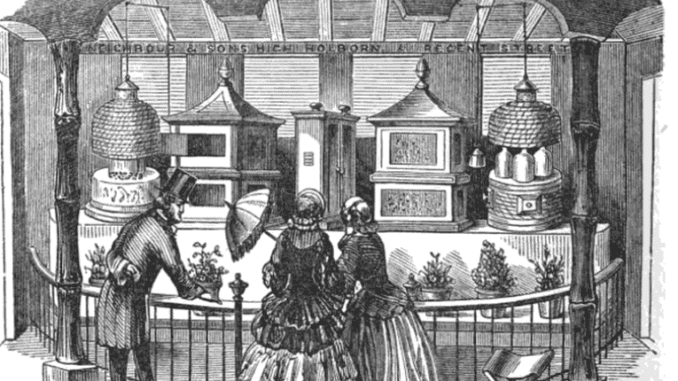
Frank Derwent and Alan Wade
In Part I of this series we examined the origins and the practice of skep beekeeping. With that narrative behind us, we now examine how this ancient way of keeping bees has morphed into the modern insulated and ventilated moveable frame hive.
Beyond the skep
The invention of the moveable frame hive came very late in the history of beekeeping. The earliest and most celebrated account of such a hive (Figure 1) comes from Sir George Wheler’s 1682 visit to St Cyriacus Monastery located on the Hymettus mountain range in the Athens area of Attica in East Central Greeceii.
The Hives they keep their Bees in, are made of Willows, or Osiers, fashioned like our common Dust-Baskets, wide at the Top, and narrow at the Bottom, and plaister’d with Clay, or Loam, within and without: They are set the wide end upwards, as you see here, The Tops being covered with broad flat Sticks, are also plaistered with Clay on the Top, and to secure them from the Weather, they cover them with a Tuft of Straw, as we do. Along each of those Sticks, the Bees fasten their Combs, so that a Combe may be taken out whole, without the least bruising, and with the greatest care imaginable. To increase them in Spring-time, that is, in March or April, until the beginning of May, they divide them; first separating the Sticks, on which the Combs and Bees are fastened, from one another with a Knife: so taking out the first Combs and Bees together, on each side, they put them into another Basket, in the same Order as they were taken out until they have equally divided them. After this, when they are both accommodated with Sticks and Plaister, they set the new Basket in the Place of the old one, and the old one in some new Place. And all this they do in the middle of the day, at such time as the greatest part of the Bees are abroad; who at their coming home, without much difficulty, by this means divide themselves equally. This Device hinders them from swarming, and flying away. In August they take out their Honey, which they do in the day-time also, while they are abroad, the Bees being thereby, they say, disturbed least. At which time they take out the Combs laden with Honey, as before; that is, beginning at each out-side, and so taking away, until they have left only such a quantity of Combs in the middle, as they judge will be sufficient to maintain the Bees in Winter; sweeping away those bees that are on the Combs they take out, into the Basket again, and again covering it with new Sticks and Plaister. All that I doubt concerning the Practise of this here in England, is, that perhaps they gather a less quantity of Honey; and that, should they take like quantity of Honey from the Bees here in England, they would not leave enough to preserve them in Winter. For this hinders not much: For by being less covetous and not taking so much Honey from the poor Bees, the great increase and multiplying of them would soon equalise, and far exceed the little Profit we make by destroying them. This is done without smoak; wherefore the Antients call this Honey ‘Αxαπνιξον Unsmoaked Honey. And I believe the Smoak of Sulphur, which we use takes away very much the Fragrancy of the Wax; and sure I am, the Honey can receive neither good Taste, nor good Smell from it.

Figure 1 Wheler’s sketch of a Greek Beehive
By the following June 1683 an anonymous ‘J.A.’iii – whom Eva Crane attributes to the antiquarian, folklorist, archaeologist, natural philosopher and writer John Aubrey [1626-1697] – had provided detailed descriptions of a rectangular hive that had frames, evenly spaced, that could be interchanged with frames from, or split off to, other hives. These hives had vertical walls sloping inwards near the base, best visualised as modern top bar hives. The lack of appreciation of bee space meant that problems of cross bracing, more particularly the adhesion of side frames to walls, remained.
So it was not till much later that more robust full frame beekeeping became common place. That came around with François Huber’siv [1750-1831] Leaf Hive (Figure 2), the first truly moveable frame hive, from which he made extended and detailed observations. His late 1780’s study of the swarming process led to the discovery of the prime swarm containing the old queen and subsequent swarms headed by virgin queensv. Rather later Johann Dzierżońvi [1811-1906] and Lorenzo Lorraine Langstrothvii [1810-1895] pioneered the spacing of frames so they could be easily removed. Dzierżoń is further credited with discovering honey bee parthenogenesis.
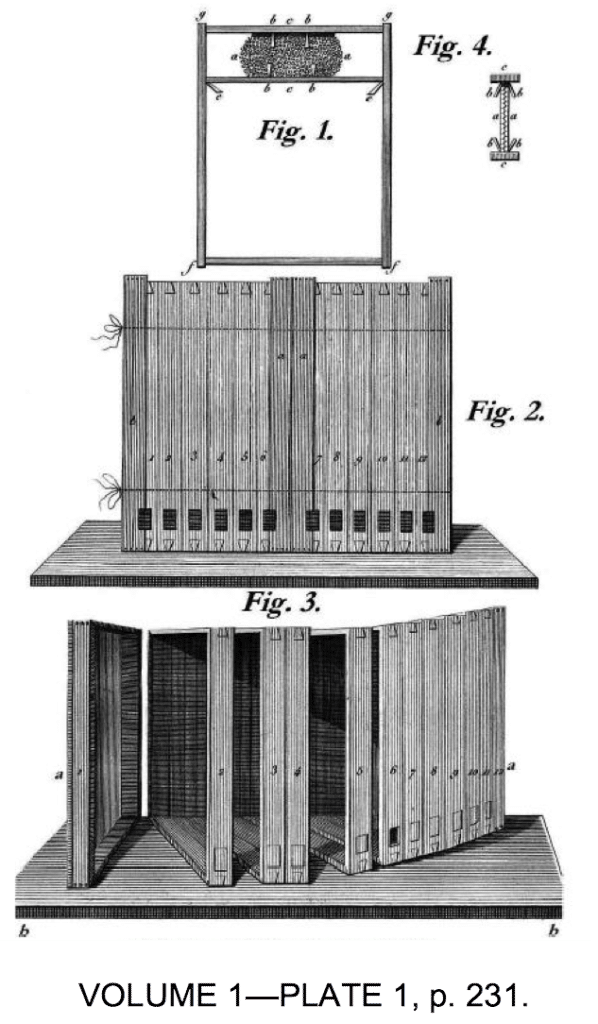
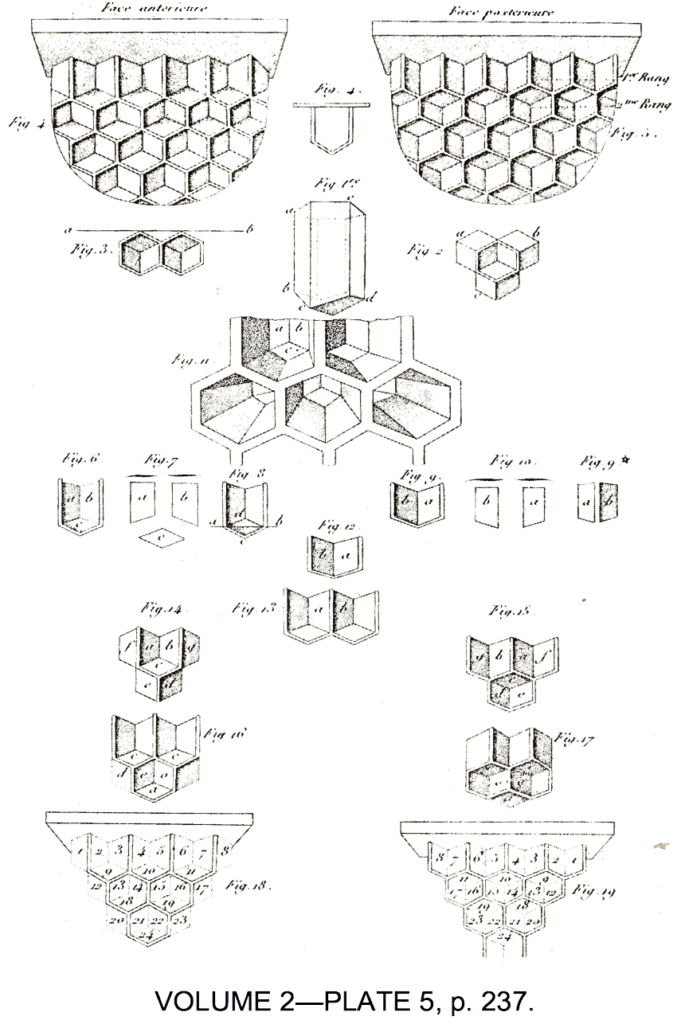
Figure 2 Huber’s 1814 Leaf Hive and his studies of comb detailviii
The impact on beekeeping of Dzierżoń’s and Huber’s many observations, and those of Langstroth’s 1851 discovery of bee space, meant that skeppist reliance on issued and captured swarms was replaced by a strategy of active swarm control and prevention. Langstroth very clearly articulated the importance of very practical moveable frame hives for modern beekeeping practice. In advertising his patented 1852 hiveix – one with a modicum of woodworking skills you can now buildx – he noted:
Each comb in this hive is attached to a separate, moveable frame, and in less than five minutes they may all be taken out, without cutting or injuring them, or at all enraging the bees… New colonies may be formed in less time than is usually required to hive a natural swarm; or the hive may be used as a non swarmer, or managed on the common swarming plan…
However skep beekeeping persisted, Alfred Neighbourxi (1886) describing many mature skep beekeeping practices, the driving of bees into empty skeps placed on top of inverted mature skeps, use of the eke (also called nadir or imp) – annular straw coils that were ‘under supered’ to extend the storage capacity of skep colonies coming into honey flows and superposition of glass bell glasses, discrete storage vessels, to the top of skeps with affixed top entrances (Figure 3). He even describes a Ladies’ Observatory or Crystal Bee-Hive and elaborates on a time of very fluid transition to modern beekeeping practice. Notably it was also a time where cottagers were the main main class of beekeeper. Neighbour, however, was acutely aware of a range of moveable frame and observation hives as well as hive supering practice all signalling a shift away from fixed comb hives such as the skep.
But both Alfred and George Neighbourxii were also familiar with the Langstroth’s frame hive and bee spacing. They described and marketed many frame hive designs, recorded many decorative hive setups and were familiar with the intricacies of François Huber’s Leaf Hive and even described the making of wax foundation:
Impressed wax sheets for artificial combs: These artificial partition walls for combs are sheets of genuine wax, about the substance of thin cardboard. They receive rhomboidal impressions by being pressed between two metal plates, carefully and mathematically prepared and cast so that the impressions are exactly the same size as the base of the cells of a honey-comb.
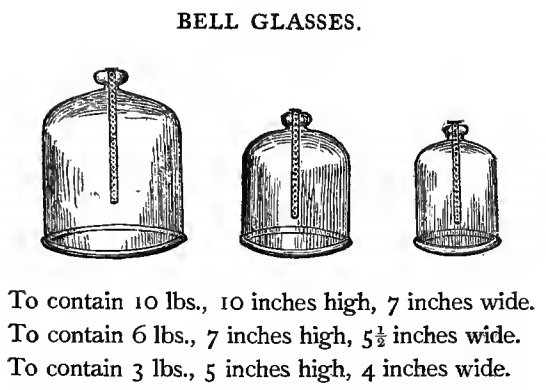


Figure 3 Neighbour’s hive records: Bell glasses: the largest for Nutt’s Hive, the middle-sized is for our Improved Cottager Hive; the smallest glass is so very small that it is not often used (above); Improved Cottager Hive [£1.15sh] with observation ports and bell glasses (left); Cottager’s Hive No. 8 for taking honey in straw caps without the destruction of the bees (below).
Later skep designs not only included a smaller woven caps positioned over the main skep but also bundled coils of sheathed straw called and eke, imp or nadir placed below the skep to provide additional space for brood rearing. There is also a history of protective hackles, weather-proofing witches hats and of bee houses, structures that are found in relic bee walls and elaborate bee shelters that persist across Europe today.
Legacies of bee skepping
Skep beekeeping is now outlawed in western countries because frames cannot be inspected for brood diseases. So the question: ‘Art thou a skeppist?’ is purely rhetorical, though the image of a skep as one of ‘a hive of industry and exemplary work ethic’ has carried over as a relic of its rich apicultural history.
Much was learnt from the keeping of bees in containers such as earthenware pots and natural log hives, not least from keeping bees in readily transportable skeps. Skepping sustained beekeeping through the Middle Ages through to the pre-Victorian era:
- providing detailed observations of the swarming behaviour of honey bees;
- recording the economic and cultural heritage of agrarian societies;
- leading to the first attempts at non-destructive honey harvesting strategies such as cutting out honey comb from hive back entrances to hives and driving of bees;
- developing the moveable frame hive;
- inventing supering, colony division and swarm control; and
- greatly facilitating the early culture of migratory beekeeping – skep hives were lightweight leading to easy transport and marketing of late swarms
Recent advances in hive design would appear to be those that replicate conditions found in the most successful wild colonies, those deep inside tree hollows, that allow bees to best regulate the internal hive environment and that protect the nest from the vicissitudes of highly variable external conditions. These boil down to improved thermal and moisture regulation and better ventilation of hives.
Möbusxiii was one of the first researchers to show that bees circulate air vertically and that single bee space between honey frames and double bee space between brood frames appears to optimise heat retention and moisture and carbon dioxide exchange. Recent studies by Mitchellxiv have shown that honey stores used to maintain bees through winter and on cold nights and the energy and hence stores required to ripen nectar are inversely correlated with hive insulation. Good insulation saves bees honey, stops them having to cluster tightly, reduces their susceptibility to diseases such as Nosema and the Varroa-DWV complex, reduces bee wing wear and bee ageing and vastly improves nectar ripening and colony water cycling dynamics.
But these are topics beyond the scope of the window on skep beekeeping. Regrettably some skepping practices such as facilitating the old practice of ‘swarming beekeeping’ (Figure 4), the lack of any effective disease control and the common neglect of beehives persist and are common enough amongst todays hive owners.
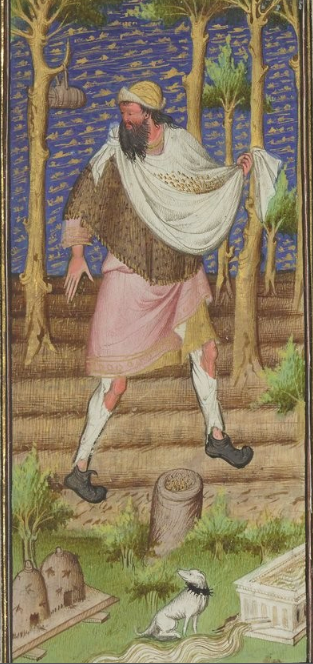
Figure
4 When
‘swarming beekeeping’ and skeps were all the go.
September in the
Rohan Hours 14th Centuryxv
Beekeepers with aspirations ‘to save the bees’ other than in skeps and to do so traditionally might start with Palladius’s 350 AD adage:
The bee-yard should not be far away but aside, clean, secret, and protected from the wind, square, and so strong that no thief can enter it.
This was rendered in Middle English asxvi De opium castris. 145:
The Bee-yerd be not ferre, but faire asyde
Gladsum, secrete, and hoote, alle from the wynde,
Square, and so bigge into hit that no thef stride
Readings
iNeighbour, A. (1866) The apiary or Bees, bee-hives and bee-culture being a familiar account of the habits of bees and the most improved methods of management, with full directions, adapted for the cottager, farmer, or scientific apiarian. Kent and Co., Paternoster Row; Geo. Neighbour and Sons, 149 Regent Street, and 127 High Holborn, London, 1865. https://victoriancollections.net.au/media/collectors/51d110e42162ef12e06aa06b/items/5341f0202162ef0a84dbc1c6/item-media/5341f0c52162ef0a84dbc6e3/original.pdf and
https://books.google.com.au/books?id=T0QDAAAAQAAJ&pg=PA129&dq=alfred+neighbour&hl=en&sa=X&ved=0ahUKEwir277v1PLiAhWHaCsKHecGDSMQ6AEIKDAA#v=onepage&q=alfred%20neighbour&f=false
iiWheler, G. (1682). A journey into Greece, by George Wheler, Esq., in company of Dr Spon of Lyons. London, 483 pp. Printed for William Cademan, Robert Kettlewell, and Awnsham Churchill. Book VI Athens to Attica pp. 412-413, Image 174. Accessible online through the National Library of Australia at http://gateway.proquest.com/openurl?ctx_ver=Z39.88-2003&res_id=xri:eebo&rft_val_fmt=&rft_id=xri:eebo:image:95495
iiiJ.A. (1683). Directions for the making of colonies for bees, and a new invented model of hive, to improve them, whereby without killing, may be enjoyed the fruit of their labour. Tuesday 16 June 1683, Letter Number VI. pp. 374-381. A collection for improvement of husbandry and trade. in Houghton, J. (1684). Husbandry and trade improved: Being a collection of many valuable materials relating to corn, cattle, coals, hops, wool, &c. with a complete catalogue of the several sorts of earths, and their proper product; the best sorts of manure for each; with the art of draining and flooding of lands as also full and exact histories of trades, as malting, brewing, &c. the description and structure of instruments for husbandry, and carriages, with the manner of their improvement. An account of the rivers of England, &c. and how far they maybe made navigable; of weights and measures, of woods, cordage, and metals; of building and stowage, the vegetation of plants, &c. with many other useful particulars, communicated by several eminent members of the Royal Society, to the Collector, Vol. IV, 414 pp. Woodman and Lyon, Russel Street, Covent Garden, London. M,DCC,XXVII. https://books.google.com.au/books?id=vL0PAAAAQAAJ&pg=PA374&lpg=PA374&dq=Directions+for+the+making+of+colonies+for+bees,+and+a+new+invented+model+of+hive,+to+improve+them,+whereby+without+killing,+may+be+enjoyed+the+fruit+of+their+labour.&source=bl&ots=QgGYcqa-9m&sig=ACfU3U1ojgkFSNoHpI__5SVl1JPQewpjxg&hl=en&sa=X&ved=2ahUKEwjHo6fYlcXiAhXg63MBHZLbDdUQ6AEwAXoECAgQAQ#v=onepage&q=Directions%20for%20the%20making%20of%20colonies%20for%20bees%2C%20and%20a%20new%20invented%20model%20of%20hive%2C%20to%20improve%20them%2C%20whereby%20without%20killing%2C%20may%20be%20enjoyed%20the%20fruit%20of%20their%20labour.&f=false
ivHuber, F. (1806). New observations on the natural history of bees, Volume 1, Letters written by François Huber between 1787 and 1791. http://www.bushfarms.com/huber.htm https://books.google.com.au/books?id=jXdlAAAAMAAJ&printsec=frontcover&dq=huber+leaf+hive+photo&hl=en&sa=X&ved=0ahUKEwiMsvTInvniAhUCfSsKHZ_aDIAQ6AEIMzAC#v=onepage&q&f=false
vLangstroth, L.L. (1878). A practical treatise on the hive and honey-bee. http://www.thebeeyard.org/wp-content/uploads/2014/02/the.Hive_.And_.The_.Honey_.Bee_.Langstroth.1853.pdf
viDzierżoń, J. (1882). Dzierzon’s rational beekeeping or The theory and the practice of Dr. Dzierzon. Translated by Dirk and Stutterd, Houlston & Sons, Paternoster Square, Southall: Abbott, Bros. https://ia800201.us.archive.org/17/items/dzierzonsration00stutgoog/dzierzonsration00stutgoog.pdf and http://reader.library.cornell.edu/docviewer/digital?id=hivebees5017629#page/5/mode/1up
viiLangstroth, L.L. (1857). Langstroth on the hive and the honey-bee: A beekeepers manual. C.M. Saxton & Co., Agricultural Booksellers – 40 Fulton Street, New York. in Chapter VII On the advantages which ought to be found in an improved hive, pp. 98-113. http://www.southeastalabamabeekeepers.com/files/A_Practical_Treatise_on_the_Hive_and_Honey_Bee.pdf
viiiHuber, Francis (1814). New Observations Upon Bees translated from the French by Dadant, G.P.. Editor of the American Bee Journal, Hamilton, Illinois, 1926. https://victoriancollections.net.au/media/collectors/51d110e42162ef12e06aa06b/items/537c1a572162ef06a03aafc4/item-media/537c1b7a2162ef06a03ab6cd/original.pdf
ixUnited States Patent Office (1912). Lorenzo L. Langstroth, of Philadelphia, Pennsylvania. Beehive. Specification forming part of Letters Patent No. 9,800, dated October 5, 1852; Reissued May 26, 1863, No. 1,484, 10 pp. https://patents.google.com/patent/US9300?Oq=beehive+honey+langstroth
Langstroth, L.L. (1853). Langstroth on the hive and the honey-bee: A beekeepers manual. Hopkins, Bridgman & Company, Northhampton, Advertisement
L L. Langstroth’s movable comb hive. Patented October 5, 1862, pp.9-10. http://www.hunter-valley-amateur-beekeepers.org/hvaba_link_documents/langstroth%20-%20the%20hive%20and%20the%20honey%20bee.pdf
xSieling, P. (October 1996). Build the original Langstroth hive. Bee Culture http://www.beeculture.com/build-original-langstroth-hive/
xiNeighbour, A. (1866). loc. cit.
xiiNeighbour, G. (May 1887). George Neighbour and Sons’ bee-hives and apparatus. The British Bee Journal and Bee-keepers Adviser 5(40):28, 46. https://books.google.com.au/books?id=afpHAAAAYAAJ&pg=PA43-IA3&dq=alfred+neighbour+beekeeper&hl=en&sa=X&ved=0ahUKEwiDqo2diPLiAhWYfH0KHYnMA6gQ6AEINDAC#v=onepage&q=alfred%20neighbour%20beekeeper&f=false
xiiiMöbus, B. (1998). Brood rearing in the winter cluster, Part I. American Bee Journal 138(7):511-514. Möbus, B. (1998). Rethinking our ideas about the winter cluster: Part II. American Bee Journal 138(8):587-591. Parts I and II. Rethinking ideas about the winter cluster can be found at http://poly-hive.co.uk/recourses/mobus-bernard-his-workon-swarming-and-wintering/brood-rearing-in-the-winter-cluster/ and Möbus, B. (1988). Damp, condensation and ventilation, Part III: The sink, damp and condensation Part I repeated and Part III, Damp, condensation and ventilation, The sink. http://poly-hive.co.uk/recourses/mobus-bernard-his-work-on-swarming-and-wintering/dampcondensation-and-ventilation/ Möbus, B (1998) Rethinking our ideas about the winter cluster. The three parts were originally published in the July, August and September 1998 editions of the American Bee Journal.
xivMitchell,
D. (2019). Thermal efficiency extends distance and variety for
honey bee foragers: Analysis of the energetics of nectar collection
and desiccation by Apis
mellifera.
Journal
of the Royal Society Interface,
26 pp.
https://royalsocietypublishing.org/doi/10.1098/rsif.2018.0879
Mitchell,
D. (2016). Ratios of colony mass to thermal conductance of tree and
manmade nest enclosures of Apis
mellifera:
implications for survival, clustering, humidity regulation and
Varroa
destructor.
International
Journal of Biometereology 60:
629-638.
https://www.ncbi.nlm.nih.gov/pubmed/26335295https://docs.google.com/viewer?a=v&pid=forums&srcid=MTQ1OTYwMzIwNzQ2NzIzNDE4MDcBMDc3NDA4MjkyOTA0MTMzNTYzMDUBUjE0WWxzVU9BZ0FKATAuMS4xAQF2Mg
xvSeptember in the Rohan Hours (BNF Latin 9471, fol. 13r), c.1430-1435. Heures. (1401-1500). Bibliothèque Nationale de France, Département des Manuscrits https://gallica.bnf.fr/ark:/12148/btv1b10515749d/f35.item
xviRutilius Taurus Aemilianus Palladius (c. 350). Palladius on Husbandrie. From the unique ms. of about 1420 A.D. in Colchester Castle. Baeton Lodge, B. Ed. with a ryme index edited by Sidney J. H. Herrtage, London: Published for The Early English Text Society by N. Trübner & Co., 57 & 59, Ludgate Hill, p.37. [Palladius’ Latin text on agriculture De Re Rustica, Opus agriculturae translated into Middle English in Of Husbandry] https://ia800901.us.archive.org/27/items/palladiusonhusbo00palluoft/palladiusonhusbo00palluoft.pdf Medieval Sourcebook: Palladius: On Husbandry, c. 350, p.37 lines 1009-1011. De opium castris. 145. https://sourcebooks.fordham.edu/source/350palladius-husbandry.asp

Be the first to comment